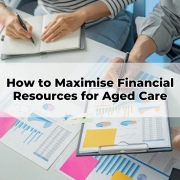When to Start Financial Planning for Aged Care
Table of Contents
ToggleAged care planning is one of the most consequential financial decisions Australians will face in later life. Yet, many families delay engaging in this process until a health crisis forces their hand. Early planning can significantly mitigate stress, maximise available resources, and ensure optimal care outcomes. Navigating residential aged care, home care packages, means-tested fees, and complex asset assessments demands foresight. Understanding when to commence financial planning can determine whether care decisions are proactive or reactive, impacting both financial security and personal wellbeing.
The Financial Consequences of Delayed Aged Care Planning
Postponing financial planning for aged care often results in rushed, ill-informed decisions under duress. Families may inadvertently incur avoidable costs or miss entitlements altogether. From the sudden sale of the family home to misunderstanding Centrelink rules, delayed action reduces flexibility. In some cases, people unwittingly exceed asset thresholds and lose access to vital subsidies. Without early structuring, it becomes harder to optimise cash flow, protect estate value, or avoid steep daily accommodation payments. Strategic aged care planning, when done early, can turn a financially stressful transition into a managed, measured one.
The Stages of Aged Care Financial Planning
Aged care financial planning is not a single event. It unfolds across several distinct stages. These include pre-retirement awareness, active retirement structuring, pre-care readiness, immediate care transition, and ongoing management. Each stage comes with its own decisions—ranging from reviewing income streams and superannuation to formalising enduring powers of attorney and assessing residential care fees. The ideal timeline hinges on recognising these phases and planning progressively. By segmenting aged care planning into stages, individuals and families can tackle decisions in a timely and less overwhelming fashion.
Starting in Your 50s: Establishing a Foundation
Financial planning for aged care ideally begins during your 50s. At this stage, individuals are typically still in the workforce, accumulating assets and shaping retirement goals. While aged care may seem distant, early groundwork here includes evaluating superannuation, consolidating assets, and setting up estate planning structures. This is the time to engage a financial adviser to model long-term care scenarios, forecast aged pension eligibility, and identify strategies that preserve wealth while supporting future care needs. Laying the foundation early gives time for strategies to mature, enabling more options later.
The 60s: Transitioning from Accumulation to Preservation
During the 60s, many Australians move into active retirement. With reduced employment income, priorities shift towards asset preservation and income sustainability. This is the decade to refine aged care financial strategies. Review investment portfolios for liquidity. Consider the implications of homeownership, assess downsizing strategies, and evaluate potential impacts on means-testing thresholds. Revisit your enduring power of attorney and ensure all legal instruments are updated. Now is also the time to initiate conversations with family members about future preferences and expectations. Strategic dialogue during this period avoids future misunderstandings and facilitates planning with clarity.
Early 70s: Anticipating Care Needs and Increasing Complexity
The early 70s mark a period where aged care considerations become more immediate. Health concerns may emerge, and care requirements begin to materialise. This phase is critical for detailed financial modelling. Assess potential aged care pathways—home care versus residential care—and their financial implications. Confirm asset ownership structures and Centrelink declarations. It’s essential to ensure liquidity to meet upfront RADs (Refundable Accommodation Deposits) or periodic DAPs (Daily Accommodation Payments). Financial advisers should also run simulations of future fee scenarios based on projected income and asset values, enabling better positioning before urgent care decisions are required.
Health Decline and Crisis Points: Managing the Urgent Transition
Health events—falls, hospitalisations, or dementia diagnoses—often act as the catalyst for aged care entry. When no planning has occurred, families are left scrambling. Decisions must be made within days, often while emotionally distressed. Without a pre-structured financial strategy, outcomes are reactive and expensive. RADs may be paid using unsuitable asset sales, or pension entitlements may be lost due to overlooked exemptions. Financial planning during this stage is still possible but significantly constrained. However, a skilled adviser can help restructure assets urgently and negotiate with providers to minimise financial fallout.
Post-Entry: Ongoing Strategy Review and Compliance
Financial planning for aged care does not end at facility entry. Ongoing reviews are essential to ensure compliance with Centrelink and DVA reporting, evaluate income stream performance, and manage annual care fee adjustments. Investment portfolios should be monitored for income sufficiency and risk alignment. Planning may also involve estate considerations, such as rebalancing the deceased estate to optimise outcomes for beneficiaries while accounting for care-related deductions. Continual engagement with an accredited aged care specialist ensures the plan remains efficient as health and financial circumstances evolve.
When Parents Age: Intergenerational Planning Considerations
Many people begin aged care planning not for themselves, but for ageing parents. Initiating the conversation can be emotionally complex but financially critical. By involving a financial adviser early, adult children can better understand aged care costs, protect the family home, and manage pension impacts. Intergenerational planning also helps align expectations among siblings and reduce the likelihood of future conflict. Moreover, strategic decisions around gifting, granny flat interests, or informal care arrangements can be made with full awareness of their Centrelink and taxation consequences.
Legal Instruments: Aligning Financial Strategy with Authority
No aged care financial plan is complete without the legal authority to implement it. Enduring powers of attorney, advance care directives, and guardianship documents must be executed while the individual still has full decision-making capacity. These instruments are not just legal niceties—they empower financial advisers and family members to act swiftly when care is required. Without them, delays in asset access or disputes over authority can significantly hamper financial strategy execution. Incorporating legal preparedness into the financial timeline ensures a smoother, more controlled transition into aged care.
Government Subsidies and the Role of Means Testing
Understanding the interplay between financial position and government subsidies is pivotal in aged care planning. The means test evaluates both income and assets, determining eligibility for subsidised care and daily fees. However, the rules are complex and subject to change. Poor timing in asset realisation or gifting can inadvertently raise aged care fees or reduce entitlements. Early financial advice allows individuals to position assets and income streams within thresholds, utilising available exemptions such as the two-year exemption on the family home when a spouse remains in it. Maximising subsidies without breaching the rules requires specialist knowledge and forward thinking.
Estate Planning and the Financial Legacy Post-Care
Aged care planning is intrinsically tied to estate planning. Entry into aged care can influence superannuation death benefits, testamentary intentions, and tax outcomes for beneficiaries. When assets are restructured for aged care affordability, their future distribution must be re-evaluated. Careful consideration should be given to retaining tax-effectiveness and fairness among beneficiaries. Moreover, conversations around advance directives, wills, and asset transfers must happen in conjunction with aged care financial advice to avoid contradictions. Coordinating estate planning alongside aged care strategy ensures a seamless legacy plan that reflects both financial prudence and personal wishes.
Conclusion
Aged care financial planning is not a conversation for tomorrow—it’s a decision for today. The earlier the planning begins, the greater the control, the broader the options, and the lower the cost. While aged care may feel far-off during one’s 50s or early 60s, it’s precisely then that the most effective strategies can be laid. Waiting until a crisis hits often limits choices and increases financial strain. With proactive, staged, and professional guidance, individuals and families can navigate the aged care journey with clarity, dignity, and financial security. Start early, plan wisely, and protect your future.









